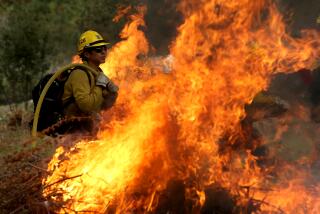State has been slow to boost firefighting capability
Although Gov. Arnold Schwarzenegger’s administration has improved its readiness for big blazes since the last major round of wildfires hit California in 2003, the state still confronted this week’s infernos without all the equipment its experts had advised.
A special panel appointed by Schwarzenegger recommended in 2004 that California buy 150 more firetrucks for emergencies. So far only 19 have been ordered. They are scheduled to arrive in time for next year’s fire season.
The state has not replaced its Vietnam-era helicopters, although the Blue Ribbon Fire Commission had warned that many were nearing the end of their operational lives and that the availability of replacements “is diminishing and will soon be exhausted.”
All told, “in some areas they have moved forward, but there’s still a long way to go,” said Mark Ghilarducci, a former emergency services official under Gov. Gray Davis who heads the Western office of James Lee Witt Associates, a crisis consulting firm.
The shape of the state’s physical resources has become one of the few flash points in a fire response that has been generally considered well-organized.
Assemblyman Todd Spitzer (R-Orange) complained Tuesday that more tankers and helicopters could have helped contain Orange County fires, saying, “We’ve all known this day was going to happen.” Spitzer did not renew his complaints Wednesday, when he traveled in the fire zone with the governor.
Schwarzenegger dismissed the complaint as “ridiculous.”
“We had the aircraft there but they couldn’t fly because of the weather conditions, and because of the wind,” he said Wednesday.
By all accounts, the state is in a much better position now than in 2003, when firefighters battled flames across Southern California. Schwarzenegger enacted two recommendations of his blue ribbon panel by boosting staffing on each engine to four firefighters in key areas, including San Diego, Riverside and San Bernardino counties, and keeping a core of firefighters on staff all year.
This year Schwarzenegger did not cut the California Department of Forestry and Fire Protection budget, despite big cuts in other departments, noted Terence McHale, a spokesman for the CDF Firefighters, the state union. “He actually augmented it.”
Carroll Wills, a spokesman for the California Professional Firefighters union, praised the department, saying, “It took almost six days in 2003 to mobilize the fire resources. Here, it was two days to bring that same volume of resources to bear.”
The state has also followed recommendations intended to reduce the amount of flammable material around homes in fire-prone areas. Last year, the state began to require residents to clear brush and flammable materials within 100 feet of their homes. Ruben Grijalva, director of the forestry department, said there have been 50,000 inspections since those standards went into place last year.
But it will take a generation before all homes meet another rule, which takes effect in January, that homes be constructed with fire-resistant materials intended to stop flying embers from setting them ablaze.
Some new developments, such as Stevenson Ranch south of Santa Clarita, that voluntarily adopted those building recommendations weathered this week’s blaze particularly well, and fire officials said they plan to study how much of a difference that made.
The gaps in the state’s equipment are due to an issue as persistent as wildfires: money. Chronically short of cash, lawmakers are buying the new firetrucks for the state Office of Emergency Services a batch at a time. The purchases have also been slowed by competitive bidding required by law and the fact that each truck is built to order. Each costs about $250,000, for a total of $37.5 million for the lot.
“It’s not like going out and buying a Ford truck,” said Mike Jarvis, a forestry department spokesman.
In addition, the state has had to replace existing firetrucks that are reaching the end of their lives. Those trucks were not included in the target increase of 150 vehicles.
Bill Campbell, a retired state senator who headed the blue ribbon commission, said the state still needs to reconcile two goals that sometimes conflict: its desire to preserve California’s natural surroundings as much as possible and its effort to deprive fires of the fuel that keeps them going.
“We still haven’t resolved the battle between the saving of lives and property versus the environmental issues,” said Campbell, a Republican who represented Orange County until 1990.
Yet it is far from clear that even if all of the panel’s recommendations had been enacted, they would have been enough to overcome the brutal combination of prolonged drought and the increasing intrusion of people into California’s wilderness.
“The problem here is we’re facing a situation where we have the worst fuel conditions in California history,” Grijalva said. “I personally don’t believe any amount of resources could have done any better than what we’re doing.”
But Ghilarducci, the emergency preparedness consultant, said the state should not become complacent about fighting fires.
“The measuring point is going to be: Are we ready for the catastrophic disaster?” he said. “Because I’ll tell you a little secret: The earthquake is coming. So we need to be prepared for that one.”
More to Read
Start your day right
Sign up for Essential California for news, features and recommendations from the L.A. Times and beyond in your inbox six days a week.
You may occasionally receive promotional content from the Los Angeles Times.






